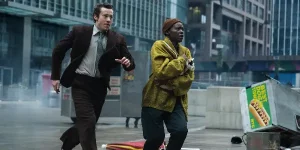
For all its influence and vision, Frank Herbert’s original Dune novel never quite hit the note the author intended. With its sweeping sci-fi vistas of desert worlds and space age T.E. Lawrences, it’s easy to see why some readers got lost in the adventure of it all—or simply extracted those fun bits for their own riffs on galaxies far, far away. Still, it was never Herbert’s goal to pen a white savior narrative about Paul Atredies, a boy hero plagued by prophecies of genocide.
After viewing the second volume of Denis Villeneuve’s grand but immensely foreboding adaptation of Dune, it’s safe to say that no one will make that same mistake about this work. Dune: Part Two is, to be sure, a profound cinematic achievement, a dense and richly layered spectacle that immerses you into strange worlds and fantastic ideas. But Villeneuve’s world of Arrakis is truly strange this time around. It’s also cruel, esoteric, and ultimately despairing. All of which makes for a splendid stage for a great tale, but in Villeneuve’s hands, one reader’s adventure yarn becomes this filmmaker’s operatic tragedy writ large enough to spill across an IMAX screen.
The seemingly doomed hero of this passion play is once again young Paul (Timothée Chalamet, fully embracing a chic messiah complex). As a quick reminder, the last film left Paul as the new patriarch and duke of his beloved House Atreides—but only because the great feudal dynasty was nearly wiped out by their grotesque rivals in House Harkonnen. In the aftermath, Paul and his mother Lady Jessica (Rebecca Ferguson) were forced to flee into the desert where they might be adopted by a native tribe of desert dwellers called Fremen… or they might be killed by them.
Yet the real subversive brilliance of Herbert’s story—which Villeneuve brings to the forefront of the movie—is that the only thing keeping Paul and Jessica alive is one uncomfortable manipulation: Jessica’s coven of space witches, the Bene Gesserit, has spent centuries brainwashing local, impoverished populaces like the Fremen into believing in messiahs and chosen one prophecies. To simply see the son of a Bene Gesserit—and his witchy mother—come in from the desert is enough to seduce fanatics like local chieftain Stilgar (Javier Bardem) and to at least intrigue the younger generation of skeptics, such as the warrior woman of Paul’s dreams, Chani (Zendaya).
Paul thus finds himself quickly going native, but only insofar as it brings him several steps closer to leading these people against House Harkonnen’s vile Baron (Stellan Skarsgård), and even the Imperium’s Emperor (Christopher Walken), who secretly condoned the murder of Paul’s father. But each move toward revenge Paul makes, with Jessica whispering in his ear to embrace the messianic complex and the holy war it will surely unleash, the closer Paul comes to becoming anything but a hero.
The complexity of Paul’s journey from vengeful son to bloodstained warmonger is Dune: Part Two’s strongest narrative element, and one that Villeneuve and Chalamet handle with care. After decades of Chosen One narratives, including in the most famous cinematic space opera which owes substantially to Dune, we return to the original idea: an inversion and warning about such tidy images promulgated by leaders and prophets. Chalamet was good in the first film at playing a wronged son; he’s better here at portraying a man struggling with a more monstrous foe—his own vanity.
Yet the success of Villeneuve’s Dune duology emanates from no single story beat or theme, but rather the collective tapestry they weave. While the general gist of the story is simple, both films retain a novelistic structure and texture, making room for fascinating vignettes and detours like the scholarly pursuits of Princess Irulan (Florence Pugh), the astute daughter of Walken’s emperor and a Bene Gesserit in training who has her own suspicions. There is also her weirding sister Lady Margot Fenring (Léa Seydoux), who is sent to the Harkonnens’ home world to inspect the next generation of that family. And, indeed, the most magnetic new addition to the mythos is the Baron’s hitherto unknown nephew and heir apparent, a reptilian Austin Butler as Feyd-Rautha.
Introduced as a cosmic riff on Gladiator’s Commodus, Feyd celebrates his birthday by slaughtering handicapped and drugged prisoners of war in a monochrome arena. He also literally feeds underlings to his vampiric paramours. It’s a big black hat that the former Elvis actor wears like a debauched rockstar who’s gone feral. In a film filled with showy performances, this is the star turn.
But the real star, again, is not any single piece but the impressive whole Villeneuve weaves. In fact, despite the film’s nearly three-hour length, there is not enough time to fully explore every curious nook and cranny. We personally could have spent a lot more time with Lady Jessica’s increasingly ambiguous machinations and her relationship with a still unborn daughter. However, when it’s the overarching vision which compels, this becomes more virtue than sin.
Like the first volume of Villeneuve’s Dune, Part Two sharply chooses to imagine a future with a deep wealth of history. Despite existing in a tomorrow where interstellar travel is possible, this cinematic telling embraces the fact that Herbert’s universe is one married to the old ways, be it through feudal fiefdoms or how folks are still fighting, dying, and drilling for special resources to make their vehicles go vroom. There is a weight and tactility to the film that emphasizes stone and wood as much as sleek metal and glistening chromatic surfaces. The emperor’s spaceship tellingly looks like a cross between a Pokéball and something Natalie Portman would’ve used in the Star Wars prequels. But on Arrakis, the Fremen’s customs and sacred temples have the scent of antiquity about them. It’s a veritable playground for production designer Patrice Vermette and costume designer Jacqueline West, the latter of whom extrapolates medieval couture from a story of princesses and dukes, and sand-swept madness in tales of religion and the desert.
Villeneuve captures all of this on the vastest scale, losing himself in sandy seas, as well as the most aloof or sinister of details. Viewers are never told why exactly the Baron has a steady stream of dead young bodies in his quarters, or what exactly it means when a pregnant woman drinks from the bodily fluids of a great sandworm. The specificity of things can go by unexplained because their cumulative, overwhelming effect is the point. The film is a feverish dream of another world that feels as real and elusive as sand slipping through your fingertips. It’s not entirely knowable, but the impression you’re left with is that you have been transported to a bleak, oppressive fantasia. It’s a place one would never want to be, and yet you do not want to leave.
That such an uncompromising vision could be made as a modern blockbuster, and that something so ultimately chilling (even with all that sun) will be embraced by a global audience, is fascinating. This is the kind of monumental moviemaking that has beguiled audiences since the dawn of cinema, but Villeneuve has spiced his vintage with a madness befitting Paul, the voice from the outer world.
Dune: Part Two opens on March 1.
The post Dune 2 Review: Denis Villenuve Makes the Bleakest Sci-Fi Masterpiece in the Galaxy appeared first on Den of Geek.







